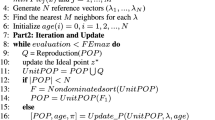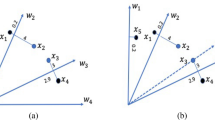Abstract
The large-scale multi-objective optimization problem exist widely in reality while they have complex constraints. The simultaneous effect of the large-scale decision variables and the complexity of constraints makes the traditional multi-objective evolutionary algorithm face great challenges. For the large-scale of decision variables, some reference vector-guided, competitive group optimization-based and pairwise child generation-based algorithms have improved the search efficiency of constrained LSMOPs. However, these algorithms encounter difficulties in handling large-scale decision variables and complex constraints at the same time. In this paper, a reference vector-guided with dominance co-evolutionary multi-objective algorithm is proposed to solve constrained large-scale multi-objective problems. First, a reference vector is employed to guide several sub-populations with a fixed number of neighborhood solutions. Then, a new environmental selection is constructed using the angle penalty distance with dominance relationship. This new environmental selection strategy greatly enhances selection pressure. At the same time, a co-evolutionary constraint handling technology is applied to efficiently span the infeasible region. The proposed algorithm is evaluated on constrained large-scale multi-objective problems with 100, 500 and 1000 decision variables. In addition, the impact of each component of the proposed algorithm is examined for the overall performance of the algorithm and tested in a practical application in microgrids. The experimental results demonstrate the effectiveness of the algorithm in constrained large-scale multi-objective optimization.








Similar content being viewed by others
Data availability
Data available on request from the authors.
References
He C, Cheng R, Zhang C, Tian Y, Yao X (2020) Evolutionary large-scale multiobjective optimization for ratio error estimation of voltage transformers. IEEE Trans Evol Comput PP(99):1–1
Kollat J B, Reed P M, Maxwell R (2011) Many‐objective groundwater monitoring network designusing bias‐aware ensemble Kalman filtering, evolutionary optimization, and visual analytics. Water Resour Res 47(2):1–18
Zhou A, Qu B-Y, Li H, Zhao S-Z, Suganthan PN, Zhang Q (2011) Multiobjective evolutionary algorithms: a survey of the state of the art. Swarm Evol Comput 1(1):32–49
Fan C, Ding C, Xiao L, Cheng F, Ai Z (2021) Deep belief ensemble network based on MOEA/D for short-term load forecasting. Nonlinear Dyn 105(3):2405–2430
Ran C, Jin Y, Olhofer M, Sendhoff B (2017) Test problems for large-scale multiobjective and many-objective optimization. IEEE Trans Cybern 47(12):4108–4121
Tian Y, Zheng X, Zhang X, Jin Y (2019) Efficient large-scale multiobjective optimization based on a competitive swarm optimizer. IEEE Trans Cybern 50(8):3696–3708
Zhang X, Tian Y, Cheng R, Jin Y (2016) A decision variable clustering-based evolutionary algorithm for large-scale many-objective optimization. IEEE Trans Evol Comput 22(1):97–112
He C, Cheng R, Tian Y, Zhang X, Tan KC, Jin Y (2020) Paired offspring generation for constrained large-scale multiobjective optimization. IEEE Trans Evol Comput 25(3):448–462
Fan Z, Fang Y, Li W, Lu J, Cai X, Wei C (2017) A comparative study of constrained multi-objective evolutionary algorithms on constrained multi-objective optimization problems. In 2017 IEEE congress on evolutionary computation (CEC). IEEE, pp. 209–216
Cheng R, Jin Y, Olhofer M, Sendhoff B (2016) A reference vector guided evolutionary algorithm for many-objective optimization. IEEE Trans Evol Comput 20(5):773–791
Trivedi A, Srinivasan D, Sanyal K, Ghosh A (2016) A survey of multiobjective evolutionary algorithms based on decomposition. IEEE Trans Evol Comput 21(3):440–462
Yu X, Yu X, Lu Y, Yen GG, Cai M (2018) Differential evolution mutation operators for constrained multi-objective optimization. Appl Soft Comput 67:452–466
Zhang Z, He C, Ye J, Xu J, Pan L (2019) Switching ripple suppressor design of the grid-connected inverters: a perspective of many-objective optimization with constraints handling. Swarm Evol Comput 44:293–303
Chen J, Li J, Xin B (2017) DMOEA-εC: decomposition-based multiobjective evolutionary algorithm with the ε-constraint framework. IEEE Trans Evol Comput 21(5):714–730
Song XF, Zhang Y, Gong DW, Gao XZ (2021) A fast hybrid feature selection based on correlation-guided clustering and particle swarm optimization for high-dimensional data. IEEE Trans Cybern PP(99):1–14
Liang J et al (2022) A survey on evolutionary constrained multi-objective optimization. IEEE Trans Evol Comput:1–1. https://doi.org/10.1109/TEVC.2022.3155533
Tian Y, Zhang T, Xiao J, Zhang X, Jin Y (2021) A coevolutionary framework for constrained multiobjective optimization problems. IEEE Trans Evol Comput 25(1):102–116
Li K, Chen R, Fu G, Yao X (2018) Two-Archive evolutionary algorithm for constrained multiobjective optimization. Evol Comput IEEE Trans 23(2):303–315
Wang J, Li Y, Zhang Q, Zhang Z, Gao S (2022) Cooperative multiobjective evolutionary algorithm with propulsive population for constrained multiobjective optimization. IEEE Trans Syst Man Cybern: Syst 52(6):3476–3491. https://doi.org/10.1109/TSMC.2021.3069986
Liu ZZ, Wang BC, Tang K (2021) Handling constrained multiobjective optimization problems via bidirectional coevolution. IEEE Trans Cybern:1–14. https://doi.org/10.1109/TCYB.2021.3056176
Cao B, Zhang Y, Zhao J, Liu X, Lv Z (2021) Recommendation based on large-scale many-objective optimization for the intelligent internet of things system. IEEE Internet Things J PP(99):1–1
Deb K, Jain H (2014) An evolutionary many-objective optimization algorithm using reference-point-based nondominated sorting approach, Part I: solving problems with box constraints. IEEE Trans Evol Comput 18(4):577–601. https://doi.org/10.1109/TEVC.2013.2281535
Ma L, Huang M, Yang S, Wang R, Wang X (2021) An adaptive localized decision variable analysis approach to large-scale multiobjective and many-objective optimization. IEEE Trans Cybern PP(99):1–13
Tian Y, Cheng R, Zhang X, Y Cheng F, Jin Y C (2018) An indicator based multi-objective evolutionary algorithm with reference point adaptation for better versatility. IEEE Trans Evol Comput 22(4):609–622
Cheng R, Jin Y, Narukawa K, Sendhoff B (2015) A multiobjective evolutionary algorithm using Gaussian process-based inverse modeling. IEEE Trans Evol Comput 19(6):838–856
Liu Q, Jin Y, Heiderich M, Rodemann T (2019) Adaptation of reference vectors for evolutionary many-objective optimization of problems with irregular Pareto fronts. In 2019 IEEE Congress on Evolutionary Computation (CEC). IEEE, pp. 1726–1733
Ye T, Ran C, Zhang X, Jin Y (2017) PlatEMO: a MATLAB platform for evolutionary multi-objective optimization. IEEE Comput Intell Mag 12(4):73–87
Coello CAC, Cortes NC (2005) Solving multiobjective optimization problems using an artificial immune system. Genet Program Evolvable Mach 6(2):163–190
Ye T, Xiang X, Zhang X, Ran C, Jin Y (2018) Sampling Reference Points on the Pareto Fronts of Benchmark Multi-Objective Optimization Problems. In 2018 IEEE Congress on Evolutionary Computation (CEC)
While L, Bradstreet L, Barone L (2012) A fast way of calculating exact hypervolumes. IEEE Trans Evol Comput 16(1):86–95
Zhou KP, Lin Y, Deng HW, Li JL, Liu CJ (2016) Prediction of rock burst classification using cloud model with entropy weight. Trans Nonferrous Metals Soc China 26(7):1995–2002
Haynes W (2013) Wilcoxon Rank Sum Test. Springer, New York
Fan Z, Li W J, Cai X Y, et al (2020) Difficulty adjustable and scalable constrained multiobjective test problem toolkit. Evol Comput 28(3):339–378
Zhang Q, Zhou A, Zhao S, Suganthan PN, Tiwari S (2008) Multiobjective optimization test instances for the CEC 2009 special session and competition, Technical Report CES-487, University of Essex, Colchester, UK, and Nanyang Technological University, Singapore, pp 1–24
Gaspar-Cunha A, Covas JA (2008) Multi-objective optimization using evolutionary algorithms. Comput Optim Appl 39(1):75–96
Deb K, Goyal M (1996) A Combined Genetic Adaptive Search (GeneAS) for engineering design. Mech Eng 1–20
Veček N, Mernik M, Filipič B, Črepinšek M (2016) Parameter tuning with Chess Rating System (CRS-Tuning) for meta-heuristic algorithms. Inf Sci 372:446–469
Devaraj R, Mahalingam SK, Esakki B, Astarita A, Mirjalili S (2022) A hybrid GA-ANFIS and F-Race tuned harmony search algorithm for Multi-Response optimization of Non-Traditional Machining process. Expert Syst Appl 199:116965
Ishibuchi H, Imada R, Setoguchi Y, Nojima Y (2018) Reference point specification in inverted generational distance for triangular linear pareto front. IEEE Trans Evol Comput 22(6):961–975
Acknowledgements
The authors are very grateful to the anonymous reviewers for their valuable comments on improving this article. Additionally, this work is supported by National Natural Science Foundation of China (No. 62262017, 62202129), Hainan Provincial Natural Science Foundation of China (123MS003), Scientific Research Project of Hunan Provincial Department of Education (No. 21C0922), Open Fund Project of Fujian Provincial Key Laboratory of Data Intensive Computing (No. BD202004), and Open Fund Project of Vehicle Measurement, Control and Safety Key Laboratory of Sichuan Province (No. QCCK2021-006).
Author information
Authors and Affiliations
Corresponding author
Additional information
Publisher's note
Springer Nature remains neutral with regard to jurisdictional claims in published maps and institutional affiliations.
Rights and permissions
Springer Nature or its licensor (e.g. a society or other partner) holds exclusive rights to this article under a publishing agreement with the author(s) or other rightsholder(s); author self-archiving of the accepted manuscript version of this article is solely governed by the terms of such publishing agreement and applicable law.
About this article
Cite this article
Fan, C., Wang, J., Yang, L.T. et al. Efficient constrained large-scale multi-objective optimization based on reference vector-guided evolutionary algorithm. Appl Intell 53, 21027–21049 (2023). https://doi.org/10.1007/s10489-023-04663-9
Accepted:
Published:
Issue Date:
DOI: https://doi.org/10.1007/s10489-023-04663-9




